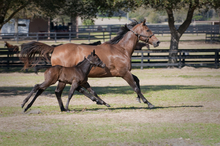Newsdate: Wed October 11, 2017, 1:00 pm
Location: GILROY, California
Often horse owners with young horses are unfamiliar with conditions that can cause lameness in their foal, weanling, or yearling. Osteochondrosis is a condition that affects the articular (joint) cartilage, and often also involves the subchondral bone just beneath the cartilage surface.

A cause of lameness in young horses
Osteochondrosis is a manifestation of developmental orthopedic disease widely recognized in young horses across many breeds.
Young horses usually present with a sudden onset of joint swelling and lameness. A recent increase in the level of exercise is sometimes part of the history. Lameness sometimes may be very mild, with a stiff action and shortened stride. Some more severely affected horses will have a 'bunny hop' action behind that can initially be confused with a neurologic problem.
Approximately 60% of affected horses will be one year of age or less at the time the condition becomes symptomatic, and younger animals that develop clinical signs often have more severe damage within the joint.
Osteochondrosis is a manifestation of developmental orthopedic disease widely recognized in young horses across many breeds. This condition is of particular interest because of its potential to cause joint effusion and lameness in horses preparing for yearling sales or entering training.
Osteochondrosis affects many horses, with estimates that more than 60 percent are found in some radiographic surveys. Although surgical treatment is often a cure, severe or untreated lesions can lead to long-term consequences including lameness.
Despite its great impact on the horse industry, the risk factors contributing to osteochondrosis development are not fully understood. As new findings from researchers emerge, previous theories are being revised, and a more definitive picture of its etiology, genetics, metabolic profile and treatment are on the horizon.
